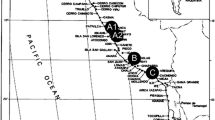Summary
The almond of commerce (Prunus dulcis (Mill.) D.A. Webb) is self-incompatible (SI) and requires honey-bees to effect the transfer of pollen among cultivars that flower simultaneously. Four year old trees from the F2 generation of several peach x almond hybrids were studied to determine whether self-compatibility (SC) and the potentiality for natural, i.e., abiotic, self pollination (NSP) are genetically related or are inherited independently. Both SC and the high potentiality for NSP are characteristic of peach (Prunus persica (L.) Batsch) but not almond. Forty percent of SC genotypes exhibited adequate NSP (SC, +NSP) for good fertility i.e., without insect-mediated pollination. The remaining 60% of SC genotypes (SC,-NSP) exhibited an average 61% reduction in fruit set on limbs bagged to exclude honeybees during anthesis relative to fruit set on open pollinated limbs. Our data are consistent with the concept that fertility is dependent upon the load of compatible pollen deposited on the stigma. Fruit set reduction on bagged limbs, compared with bagged and self-pollinated limbs, was presumably due to a) lack of/insufficient pollination for fertilization and/or b) post-zygotic abortion of genetically inferior recombinants. Selection following manual self-pollination may result in SC genotypes with or without the capacity for NSP. In contrast, significant fruit set on limbs enclosed during pistil receptivity necessitates that the genotype selected express both SC and the potentiality for NSP.
Similar content being viewed by others
References
Armstrong, D.L., 1957. A cytogenetic study of some derivatives of the F1 hybrid Prunus amygdalus x P. persica. Ph.D. dissertation, University of California, Davis.
Detjen, L.R., 1944. Fruitfulness in peaches and its relationship to morphology and physiology of pollen grains. Univ. Del. Agr. Expt. Sta. Bull. No. 257, 24 pp.
Godini, A., E. Ferrara, S. Reina, V. Giorgio, & F. Guida, 1977. Contribut alla Conoscenza delle cultivar di mandorlo (P. amygdalus Batsch) della Puglia. III. Un triennio di prove d'simpollinazione incrociata, 3rd Coll., Groupe Recherche et d'Etudes Méditerranéen pour l'Amandier, Bari, Centre Internationale des Hautes Etudes d'Agronomie Méditerranéenes, MontPellier, pp. 194–206.
Griggs, W.H., 1953. Pollination requirements of fruits and nuts. Calif. Agric. Exp. Stn. Civc. 424, 35 pp.
Harrold, T.J., 1935. Comparative study of the developing and aborting fruit of Prunus persica. Bot. Gaz. 96: 505–520.
Hesse, C.O. 1975. Peaches. pp. 285–335. In: J. Janick & J.N. Moore (Eds.), Advances in Fruit Breeding. Purdue University Press, West Lafayette, Indiana.
Kester, D.E. & W.H. Griggs, 1959. Fruit setting in the almond: the effects of cross pollinating various percentage of flowers. Proc. Amer. Soc. Hort. Sci. 74: 206–213.
Langridge, D.F., P.T. Jenkins & R.D. Goodman, 1977. A study of pollination of dessert peaches cv. Crawford. Aust. J. Exp. Agr. Anim. Husb. 17: 697–699.
Langridge, D.F. & R.D. Goodman, 1979. Pollination of canning peaches cv. Golden Queen. Aust. J. Exp. Agr. Anim. Husb. 19: 510–512.
de Nettancourt, D., 1977. Incompatibility in angiosperms. Springer-Verlag, Berlin.
Pimienta, E. & V.S. Polito, 1983. Embryo sac development in almond [Prunus dulcis (Mill.) D.A. Webb] as affected by cross-, self and non-pollination. Ann. Bot. 51: 469–479.
Pimienta, E., V.S. Polito & D.E. Kester, 1983. Pollen tube growth in cross- and self-pollinated ‘Nonpareil’ almond. J. Amer. Soc. Hort. Sci. 108: 643–647.
Ragland, C.H., 1934. The development of peach fruit with special reference to split-pit and gumming. Proc. Amer. Soc. Hort. Sci. 31: 1–21.
Socias i Company, R., 1983. Flower sterility in almond. Acta Hort. 139: 69–73.
Socias i Company, R., D.E. Kester & M.V. Bradley, 1976. Effects of temperature and genotype on pollen tube growth in some self-incompatible and self-compatible almond cultivars. J. Amer. Soc. Hort. Sci. 101: 490–493.
Stephenson, A.G., 1981. Flower and fruit abortion: proximate causes and ultimate functions. Ann. Rev. Ecol. Syst. 12: 253–279.
Thorp, R.W., 1978. Bee management for almond pollination. In: Almond Orchard Management. University of California Priced Publication 4092, pp. 57–61.
Vasilakakis, M. & I.C. Porlingis, 1984. Self-compatibility in ‘Truoito’ almond and the effect of temperature on selfed an crossed pollen tube growth. HortScience, 19: 659–661.
Weinbaum, S.A. & A. Erez, 1983. Autogamy among selected peach and nectarine cultivars. Fruit Var. J 37: 113–114.
Weinbaum, S.A., V.S. Polito & D.E. Kester, 1985. Natural self-pollination in peach, almond, and peach x almond interspecific F1 hybrids. Euphytica 35: 193–200.
Author information
Authors and Affiliations
Rights and permissions
About this article
Cite this article
Weinbaum, S.A., Shaw, D.V. & Muraoka, T.T. Independence of self-compatibility and potentiality for self-pollination in peach x almond hybrids. Euphytica 41, 53–58 (1989). https://doi.org/10.1007/BF00022410
Received:
Accepted:
Issue Date:
DOI: https://doi.org/10.1007/BF00022410




